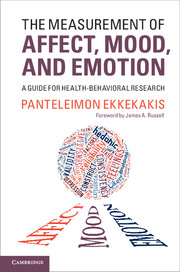Book contents
- Frontmatter
- Contents
- Figures
- Foreword
- Prologue
- 1 Documenting the breadth and depth of the problem
- 2 Untangling the terminological Gordian knot
- 3 Should affective states be considered as distinct entities or as positioned along dimensions?
- 4 Are pleasant and unpleasant states independent or polar opposites?
- 5 Selecting a measure
- 6 The old classics
- 7 Dimensional measures
- 8 Domain-specific measurement
- 9 Problems of domain specificity
- Epilogue
- References
- Index
2 - Untangling the terminological Gordian knot
Published online by Cambridge University Press: 05 March 2013
- Frontmatter
- Contents
- Figures
- Foreword
- Prologue
- 1 Documenting the breadth and depth of the problem
- 2 Untangling the terminological Gordian knot
- 3 Should affective states be considered as distinct entities or as positioned along dimensions?
- 4 Are pleasant and unpleasant states independent or polar opposites?
- 5 Selecting a measure
- 6 The old classics
- 7 Dimensional measures
- 8 Domain-specific measurement
- 9 Problems of domain specificity
- Epilogue
- References
- Index
Summary
The introductory chapter presented evidence that the conceptualization and measurement of affect, mood, and emotion within the field of health-behavioral research is presently not optimal. Among the problems identified, the most prevalent is the tendency to employ measures without presenting a supporting rationale. There are indications that this widespread phenomenon may reflect a serious underlying problem, namely that measures are often selected without following a systematic and well-grounded decision-making process.
Primary among the problems surveyed in the first chapter is the fact that the important distinctions between the constructs of affect, mood, and emotion are commonly ignored and the terms are used interchangeably. Thus, the aim of the present chapter is to codify the major differences between the constructs of affect, mood, and emotion. The main challenge inherent in this task is that these distinctions are neither clear-cut nor universally agreed upon. So, in attempting this tentative codification, one looks for the “lowest common denominator,” namely any detectable signs of consensus in the contemporary theoretical literature on this topic. Even with this challenge, drawing some lines of demarcation remains of paramount importance. For researchers contemplating the selection of a measure, forming a crystalized decision about which construct they want to study should be considered the essential first step, a sine qua non.
- Type
- Chapter
- Information
- The Measurement of Affect, Mood, and EmotionA Guide for Health-Behavioral Research, pp. 33 - 51Publisher: Cambridge University PressPrint publication year: 2013
- 3
- Cited by



